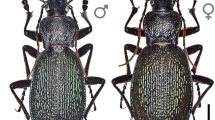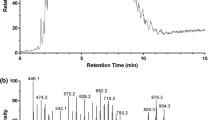Abstract
Analyses of pygidial gland contents of two species of a previously uninvestigated family of beetles (Trachypachidae) by Gas Chromatography-Mass Spectrometry (GC-MS) revealed that their chemistry is similar to that reported from many members of the family Carabidae. Nevertheless, the composition ofDefensive gland fluids of the two species Trachypachus slevini and T. gibbsii differs sufficiently to distinguish between the two species solely on the basis of theirDefensive chemistry. The major components of T. slevini glandular fluid are methacrylic, tiglic, and octanoic (= caprylic) acids, together with the hydrocarbon (Z)-9-pentacosene. In contrast, the glandular contents of T. gibbsii contain a rather unique mixture of polar and nonpolar compounds, the principal constituents of which are methacrylic and ethacrylic acids (= 2-ethylacrylic acid), together with 2-phenylethanol, 2-phenylethyl methacrylate, 2-phenylethyl ethacrylate, and (Z)-9-pentacosene.
Similar content being viewed by others
References
Arndt, E. 1993. Phylogenetische untersuchungen larvalmorphologischer MerkmaleDer Carabidae (Insecta: Coleoptera). Stuttgarter Beiträge zur Naturkunde, Serie A (Biologie) 488:1–56.
Bell, R. T. 1966. Trachypachus and the origin of the Hydradephaga (Coleoptera: Carabidae). Coleopterists Bull. 20:107–112.
Beutel, R. G. 1995. The Adephaga (Coleoptera): Phylogeny and evolutionary history, pp. 173–217, in J. Pakaluk and S. A. Slipinski (eds.). Biology, Phylogeny, and Classification of Coleoptera: Papers Celebrating the 80th Birthday of Roy A. Crowson. Muzeum i Instytut Zoologii PAN, Warszawa, Poland.
Beutel, R.G. and Haas, F. 2000. Phylogenetic relationships of the suborders of Coleoptera (Insecta). Cladistics 16:103–141.
Benn, M. H., Lencucha, A., Maxie, S., and Telang, S. A. 1973. The pygidialDefensive secretion of Carabus taedatus (Col. Carabidae). J. Insect Physiol. 19:2173–2176.
Blum, M. S. 1981. Chemical Defenses in Arthropods. Academic Press, New York. 562p.
Calam, D. H. 1969. Species and sex-specific compounds from the heads of male bumblebees (Bombus spp.). Nature 221:856–857.
Dazzini-Valcurone, M. and Pavan, M. 1980. Glandole pigidiali e secrezioni difensiveDei Carabidae (Insecta Coleoptera). PublicazioniDell'Istituto di EntomologiaDell'Universita di Pavia No 12:1–36.
Dettner, K. 1985. Ecological and phylogenetic significance ofDefensive compounds from pygidial glands of Hydradephaga (Coleoptera). Proc. Acad. Natl. Sci. Phil. 137:156–171.
Dettner, K. 1987. Chemosystematics and evolution of beetle chemicalDefenses. Annu. Rev. Entomol. 32:17–48.
Dettner, K. 1990. Chemische Abwehr beiDer ursprunglichen KäferfamilieDer Amphizoidae—ein Beitrag zur EvolutionDer PygidialdruseDer Hydradephaga. MitteilungenDer Deutschen Gesellschaft fuer Allgemeine und Angewandte Entomologie 7:519–526.
Deuve, T. 1993. L'abdomen et les genitaliaDes femellesDe Coléoptrès Adephaga. Mémoires du Muséum National d'Histoire Naturelle 155:1–184.
Eisner, T., Meinwald, J., Monro, A., and Ghent, R. 1961. Defense mechanisms of arthropods. I. The composition and function of the spray of the whipscorpion, Mastigoproctus giganteus. J. Insect Physiol. 6:272–298.
Erwin, T. L. 1985. The taxon pulse: A general pattern of lineage radiation and extinction among carabid beetles, pp. 437–472, in G. E. Ball (ed.). Taxonomy, Phylogeny, and Zoogeography of Beetles and Ants: A Volume Dedicated to the Memory of Philip Jackson Darlington, Jr., 1904-1983. Dr. W. Junk b.v., The Hague, The Netherlands.
Francis, G. W. and Veland, K. 1981. Alkylthiolation for theDetermination of double-bond position in liner alkenes. J. Chromatogr. 219:379–384.
Hammond, P. M. 1979. Wing-folding mechanisms of beetles, with special reference to investigations of adephagan phylogeny (Coleoptera), pp. 113–180, in T. L. Erwin, G. E. Ball, D. R. Whitehead, and A. L. Halpern (eds.). Carabid Beetles: Their Evolution, Natural History, and Classification. Dr. W. Junk b.v., The Hague, The Netherlands.
Jew, S. S., Kim, H. O., Jeong, B. S., and Park, H. G. 1997. Asymmetric synthesis of (S)-(′)-etomoxir. Tetrahedron: Asymmetry 8:1187–1192.
Kavanaugh, D. H. 1986. A systematic review of amphizoid beetles (Amphizoidae: Coleoptera) and their phylogenetic relationships to other Adephaga. Proc. California Acad. Sci. 44:67–109.
Meinwald, J. and Eisner, T. 1995. The chemistry of phyletic dominance, pp. 29–40, in J. Meinwald and T. Eisner (eds.). Chemical Ecology: The Chemistry of Biotic Interaction. National Academy Press, Washington D.C.
Moore, B. P. 1979. ChemicalDefense in carabids and its bearing on phylogeny, pp. 193–203, in T. L. Erwin, G. E. Ball, D. R. Whitehead, and A. L. Halpern (eds.). Carabid Beetles: Their Evolution, Natural History, and Classification. Dr. W. Junk b.v., The Hague, The Netherlands.
Moore, B. P. and Brown, W. V. 1979. Chemical composition of theDefensive secretion in Dyschirius Bonelli (Coleoptera: Carabidae: Scaritinae) and its taxonomic significance. J. Austr. Entomol. Soc. 18:123–125.
Moore, B. P. and Wallbank, B. E. 1968. Chemical composition of theDefensive secretion in carabid beetles and its importance as a taxonomic character. Proc. R. Ent. Soc. Lond (B) 37:62–72.
Roughley, R. E. 1981. Trachypachidae and Hydradephaga (Coleoptera): A monophyletic unit. Pan-Pacific Entomol. 57:273–285.
Shull, V. L., Vogler, A. P., Baker, M. D., Maddison, D. R., and Hammond, P. M. 2001. Sequence alignment of 18S ribosomal RNA and the basal relationships of adephagan beetles: Evidence for monophyly of aquatic families and the placement of Trachypachidae. Systematic Biol. 50:945–969.
Tschinkel, W. R. 1975. Comparative study of the chemicalDefensive system of tenebrionid bettles. Chemistry of the secretions. J. Insect Physiol. 21:753–783.
Wadsworth, W. S. and Emmons, W. D. 1961. The utility of phosphonate carbanions in olefin synthesis. J. Am. Chem. Soc. 83:1733–1738.
Waterhouse, D. F. and Wallbank, B. E. 1967. 2-Methylene butanal and related compounds in theDefensive scent of platyzosteria cockroaches. J. Insect Physiol. 13:1657–1669.
Will, K. W. 2000. Systematics and zoogeography of abaryform genera (Coleoptera: Carabidae: Pterostichini), and a phylogenetic hypothesis for pterostichine genera. PhD dissertation. Cornell University, Ithaca, New York. 289p.
Will, K. W., Attygalle, A. B., and Herath, K. 2000. NewDefensive chemical data for ground beetles (Coleoptera: Carabidae): Interpretations in a phylogenetic framework. Biol. J. Linn. Soc. 71:459–481.
Author information
Authors and Affiliations
Rights and permissions
About this article
Cite this article
Attygalle, A.B., Wu, X., Ruzicka, J. et al. Defensive Chemicals of Two Species of Trachypachus Motschulski. J Chem Ecol 30, 577–588 (2004). https://doi.org/10.1023/B:JOEC.0000018630.79922.94
Issue Date:
DOI: https://doi.org/10.1023/B:JOEC.0000018630.79922.94




